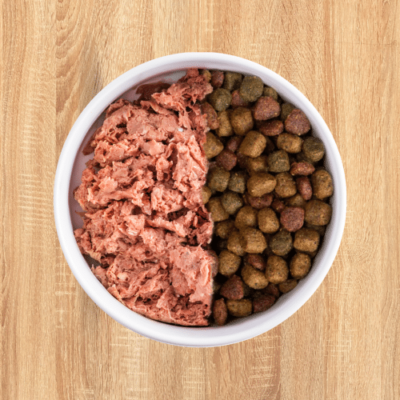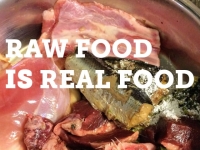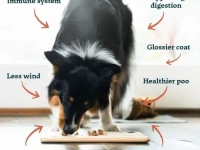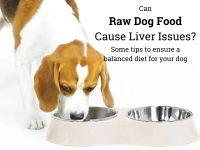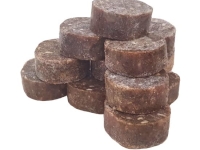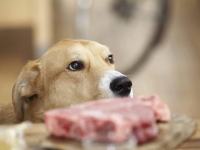The Complete Guide to Raw Dog Food Diet: The Benefits for Healthier Dogs
In This Article...
THE OVERVIEW...
The Complete Guide to a Raw Dog Food Diet: The Benefits for Healthier Dogs
In recent years, the trend of feeding dogs a raw diet has gained significant traction among dog owners seeking to improve their dog’s overall health. A raw dog food diet typically consists of uncooked meat, bones, fruits, and vegetables, aiming to replicate the natural diet of canines. This guide will explore the various aspects of raw feeding, including its benefits, how to transition your dog to this new diet, and common myths that surround raw dog food.
What is a Raw Dog Food Diet?
Understanding the Basics of Raw Diet for Dogs
A raw dog food diet is designed to provide a more natural and species-appropriate way of feeding your dog. At its core, this diet emphasizes the use of fresh, unprocessed ingredients, typically including high-quality raw meat, bones, and organ meats. These components aim to deliver essential nutrients that support your dog’s health. The premise behind raw feeding is to mimic the ancestral diet of dogs, which primarily consisted of raw prey. This biologically appropriate raw food (BARF) model is grounded in the belief that dogs thrive on a diet that closely resembles what their wild ancestors consumed, thus promoting better digestion, energy levels, and overall well-being.
Moreover, the raw dog food diet can also help reduce the presence of artificial additives, fillers, and preservatives commonly found in many commercial pet food products. Dog owners are increasingly concerned about the quality of pet food available on the market and are turning to raw feeding as a solution. This approach not only caters to the natural dietary needs of dogs but also allows for greater control over the ingredients consumed, ensuring that each meal is tailored specifically to the dog’s needs and preferences. Overall, understanding the basics of a raw diet for dogs is the first step toward unlocking the benefits of this wholesome feeding method.
What Types of Raw Dog Food Are Available?
When it comes to raw dog food, there are several types available, catering to various preferences and needs. One popular option is the commercially prepared raw pet food, which often comes in frozen or freeze-dried forms, ensuring a convenient feeding experience for dog owners. These products are formulated to provide a balanced raw diet, often containing a mixture of meat, bones, and vegetables, and are designed to meet the nutritional standards for dogs. This option is popular among owners who want to feed their dogs raw without the hassle of preparing meals themselves.
Another choice is homemade raw dog food, which allows dog owners to have full control over the ingredients and their proportions. However, it requires careful planning and knowledge to ensure that the homemade diet is complete and balanced, providing all the necessary nutrients. Additionally, some owners may choose to feed raw meaty bones, which can offer dental benefits and serve as a natural source of nutrients. Regardless of the type chosen, it is essential to ensure that the raw food diet for dogs is well-rounded and meets the specific dietary needs of each individual dog.
How Does Raw Feeding Differ from Commercial Pet Food?
Raw feeding significantly differs from traditional commercial pet food in several ways, primarily related to ingredient quality, nutrient composition, and processing methods. Commercial pet food often contains highly processed ingredients, including fillers, artificial preservatives, and by-products, which may detract from the overall nutritional value of the food. In contrast, a raw dog food diet consists of fresh, whole ingredients that aim to provide a complete and balanced diet for dogs, ensuring optimal health outcomes. This difference in ingredient quality can lead to enhanced digestion and nutrient absorption in dogs.
Furthermore, raw feeding emphasizes the importance of a biologically appropriate diet that aligns with a dog’s natural dietary instincts. Many commercial pet food brands formulate their products based on convenience and shelf stability rather than the nutritional needs of dogs. This can result in imbalances in their diet, potentially leading to health issues. By choosing to feed raw, dog owners can be more mindful of their pet’s dietary choices, ensuring that they are consuming food that is not only nutritious but also closely mirrors what they would find in the wild. Understanding these distinctions is crucial for dog owners considering a transition to raw feeding.
Benefits of Feeding Your Dog a Raw Diet
What Are the Health Benefits of a Raw Food Diet for Dogs?
Feeding a raw diet to dogs offers numerous health benefits that can lead to an improved quality of life. One of the most notable advantages is enhanced digestion, as raw dog food is typically easier for dogs to break down and assimilate, leading to better nutrient absorption. Additionally, many dog owners report improvements in their pets’ energy levels, coat condition, and overall vitality when switching to a raw food diet. The natural ingredients in raw pet food can contribute to healthier skin, shinier coats, and a reduction in common health issues, such as gastrointestinal problems.
Another significant benefit of a raw diet is its potential to support healthy weight management. Since raw feeding emphasizes high-quality protein sources and lower carbohydrate content, it can help dogs maintain a healthy weight and muscle mass. This is particularly beneficial for adult dogs, as obesity can lead to a myriad of health problems, including joint issues and diabetes. By providing a raw diet that meets their specific nutritional needs, dog owners can help ensure their pets stay fit and active, ultimately enhancing their overall well-being.
How Does a Raw Diet Support a Dog’s Natural Diet?
A raw food diet for dogs is designed to closely mimic the natural diet that canines would consume in the wild, which is predominantly composed of raw meat, bones, and other whole food items. This alignment with a dog’s natural dietary instincts can lead to various health benefits, as dogs are biologically adapted to digest and utilize these types of foods more efficiently than processed alternatives. By feeding raw, dog owners can provide their pets with a diet that satisfies their intrinsic nutritional requirements, which can positively impact their overall health.
Moreover, a raw diet encourages dogs to engage in natural chewing behaviors, which can help maintain dental health and promote strong jaw muscles. Chewing on raw meaty bones can naturally clean teeth and gums, reducing plaque buildup and preventing periodontal disease. This aspect of raw feeding supports a dog’s natural behaviors and instincts, further contributing to their physical and mental well-being. Ultimately, by providing a raw diet that aligns with a dog’s natural dietary patterns, owners can foster a healthier and more fulfilling lifestyle for their furry companions.
Can Raw Feeding Help with Allergies and Skin Conditions?
Many dog owners have turned to raw feeding as a solution for common allergies and skin conditions in their pets. A raw dog food diet eliminates many of the artificial additives and fillers found in commercial pet food, which are often culprits behind allergic reactions. By providing a diet rich in natural ingredients, owners are better equipped to pinpoint and remove allergens from their dogs’ diets while potentially reducing the incidence of skin irritations and food sensitivities. The simplicity of a raw food diet allows for greater transparency regarding the ingredients consumed, making it easier to identify triggers for allergies.
Furthermore, the high-quality proteins and essential fatty acids present in raw dog food can contribute to healthier skin and a lustrous coat. Many owners report improvements in their dogs’ skin conditions and overall coat quality after transitioning to a raw diet. Omega-3 and Omega-6 fatty acids, found in certain raw meats and fish, play a crucial role in maintaining skin health and reducing inflammation. By addressing nutritional deficiencies and promoting a balanced raw diet, dog owners may find that raw feeding is an effective strategy for managing allergies and skin conditions in their pets.
How to Transition Your Dog to a Raw Food Diet
What Steps Should You Take When Switching to Raw Feeding?
Transitioning your dog to a raw food diet requires careful planning and gradual implementation to ensure a smooth switch and minimize digestive upset. The first step is to familiarize yourself with the principles of raw feeding and to choose a balanced raw diet that meets your dog’s nutritional needs. It’s essential to consult with your veterinarian or a pet nutritionist to develop a tailored plan that incorporates the right proportions of raw meat, bones, and vegetables. This preparation will help you make informed decisions as you begin the transition.
Once you have a solid understanding of the raw dog food diet, start by introducing small amounts of raw food alongside your dog’s current commercial pet food. This gradual approach, often referred to as “mixing,” allows your dog’s digestive system to adapt to the new ingredients. Over the course of several days to a week, gradually increase the proportion of raw food while decreasing the amount of commercial food. Monitoring your dog’s response during this transition is crucial, as it allows you to adjust the process according to their individual needs and preferences.
How Much Raw Food Should You Feed Your Dog?
Determining the appropriate amount of raw food to feed your dog is essential for maintaining a balanced diet and ensuring optimal health. Generally, the recommended daily intake of raw food is approximately 2-3% of your dog’s ideal body weight, but this can vary based on factors such as age, activity level, and metabolic rate. For example, an active adult dog may require a higher percentage of raw food compared to a more sedentary pet. Using this guideline, dog owners can calculate the amount of raw food needed for their dogs, allowing for adjustments as necessary.
Additionally, it is advisable to monitor your dog’s weight and overall health during the transition to raw feeding. Regularly assess your pet’s condition, adjusting the amount of raw food as needed to ensure they are maintaining a healthy weight. Pay attention to your dog’s energy levels, coat condition, and overall well-being, as these factors can provide insight into whether the raw feeding regimen is meeting their nutritional needs. This attentive approach will help you gauge the right amount of raw food for your dog and facilitate a successful transition to a raw diet.
For more information, sign up to the Kuri feeding guide at the bottom of this page
What Common Challenges Might Arise When Transitioning?
Transitioning your dog to a raw food diet may present several challenges, but being aware of these potential issues can help streamline the process. One common concern is digestive upset, which can occur as your dog’s system adjusts to the new ingredients. Symptoms may include diarrhea, vomiting, or changes in appetite. To mitigate these issues, it is essential to implement a gradual transition, allowing your dog’s digestive system time to adapt. If digestive upset persists, it may be best to consult with your veterinarian for guidance on how to proceed.
Another challenge can be the reluctance of some dogs to accept raw food, particularly if they are accustomed to commercial pet food. To encourage acceptance, consider experimenting with different types of raw meat, as dogs may have preferences for certain proteins. Additionally, incorporating tasty toppers, such as bone broth or pureed fruits and vegetables, can enhance the appeal of the new diet. Engaging in patience and persistence will ultimately aid in successfully transitioning your dog to a raw food diet.
Choosing the Right Raw Dog Food
What Ingredients Should Be Included in a Balanced Raw Diet?
When selecting ingredients for a balanced raw diet, it is vital to include a variety of protein sources, organ meats, and appropriate supplements to ensure your dog receives comprehensive nutrition. A well-rounded raw dog food diet should primarily consist of high-quality raw meat, such as beef, chicken, or lamb, which provides essential amino acids necessary for muscle development and overall health. Additionally, incorporating organ meats like liver and kidney is crucial, as they are nutrient-dense and supply important vitamins and minerals that support various bodily functions.
Including raw meaty bones in your dog’s diet is also important, as they provide calcium and promote dental health through natural chewing. Furthermore, adding a selection of fruits and vegetables can enhance the nutrient profile of the diet by supplying antioxidants, fiber, and other beneficial compounds. It is essential to strike a balance among these components to achieve a complete and balanced diet that caters to your dog’s specific nutritional needs. Consulting with a pet nutritionist can provide valuable insights into crafting a diet tailored to your dog’s individual requirements.
At Kuri, we provide a range of common and novel proteins with a mix of organ meat to ensure that there is sufficient variety and balance for your dog.
How to Select the Best Raw Meat for Your Dog?
Selecting the best raw meat for your dog is a crucial aspect of feeding a raw diet, as the quality of the meat directly impacts your dog’s health and well-being. When choosing raw meat, prioritize high-quality sources that are free from additives, hormones, and antibiotics. Opting for human-grade meat ensures that the meat has been produced under strict food safety regulations, which is vital for your dog’s health. Additionally, sourcing meat from reputable suppliers or local farms can further enhance the quality of the raw dog food you provide.
It is also important to consider incorporating a variety of meats in your dog’s diet, as this can help prevent nutritional deficiencies and provide a broader range of nutrients. Rotating proteins such as beef, chicken, turkey, and lamb can help ensure that your dog receives a well-rounded diet. Furthermore, being mindful of any specific dietary restrictions or allergies your dog may have is essential when selecting raw meat. By carefully choosing the right raw meat, dog owners can ensure that their pets benefit from a healthy and nutritious raw feeding regimen.
What Are Raw Meaty Bones and How Can They Benefit Your Dog?
Raw meaty bones are an essential component of a balanced raw dog food diet, providing both nutritional benefits and promoting dental health. These bones typically contain meat and connective tissue, making them an excellent source of protein, calcium, and essential fatty acids. Feeding raw meaty bones encourages natural chewing behavior, which can help maintain your dog’s dental hygiene by reducing plaque buildup and promoting strong teeth and gums. This aspect of raw feeding not only contributes to physical health but also satisfies your dog’s instinctual needs.
Additionally, raw meaty bones can serve as a natural source of mental stimulation for dogs, as the act of chewing and gnawing provides an engaging activity that keeps them occupied. It is essential to select bones that are appropriate for your dog’s size and chewing habits to ensure safety during consumption. Avoid cooked bones, as they can splinter and pose a choking hazard. By incorporating raw meaty bones into your dog’s diet, you can enhance their overall health while also satisfying their natural instincts and behaviors.
Common Myths About Raw Dog Food
Is Raw Feeding Dangerous for Dogs?
One prevalent myth surrounding raw dog food is that it poses significant dangers to dogs. While there are valid concerns regarding food safety, such as the potential for bacterial contamination, it is essential to approach raw feeding with proper knowledge and practices. By sourcing high-quality ingredients, practicing good hygiene during food preparation, and storing raw food correctly, the risks associated with feeding a raw diet can be significantly minimized. Many dog owners successfully feed raw diets without encountering health issues, often reporting improved overall well-being in their pets.
Furthermore, it’s crucial to recognize that commercial pet food is not without its risks. Many dog owners have reported adverse reactions to various commercial diets, including allergies and gastrointestinal problems. By opting for a well-researched raw food diet and following safe food handling practices, dog owners can provide their pets with a nutritious and beneficial feeding regimen. Education and awareness about the potential risks and how to mitigate them are key to dispelling the myth that raw feeding is inherently dangerous for dogs.
Do Dogs Really Need Grains in Their Diet?
Another common misconception is that dogs require grains as a staple in their diet. In fact, dogs are omnivores, and their digestive systems are well-equipped to handle a variety of foods, including proteins and vegetables. A raw dog food diet that is rich in raw meat, bones, and vegetables can provide all the essential nutrients needed for optimal health without the inclusion of grains. Many dog owners have successfully transitioned their pets to grain-free diets, reporting improvements in digestion, skin conditions, and overall vitality.
Moreover, certain grains can pose challenges for some dogs, particularly those with sensitivities or allergies. By choosing a raw diet that focuses on high-quality proteins and nutrient-dense vegetables, dog owners can ensure that their pets receive a balanced and nutritious meal without the potential drawbacks of grains. Ultimately, understanding that dogs do not inherently need grains in their diet allows for a more tailored approach to their nutrition, catering to their individual needs and health considerations.
Can All Dogs Thrive on a Raw Diet?
While many dogs can thrive on a raw diet, it is essential to approach raw feeding with consideration for each dog’s unique needs and health conditions. Factors such as age, health status, and specific dietary requirements can influence whether a raw food diet is suitable for a particular dog. For example, some dogs with certain medical conditions, such as pancreatitis or diabetes, may require specialized diets that differ from a typical raw feeding regimen. Consulting with a veterinarian or a pet nutritionist is vital when considering a raw diet for dogs with specific health concerns.
Additionally, individual preferences and palatability can vary among dogs, which may affect their willingness to accept a raw diet. Some dogs may be more resistant to trying raw food, necessitating a gradual and patient approach to transitioning. By assessing each dog’s unique situation and making informed choices, dog owners can determine if a raw diet is appropriate for their pets, ensuring a successful and beneficial feeding experience.
Veterinary concerns and opportunities with clients feeding raw diets to their pets
Veterinarians often encounter concerns related to raw feeding, particularly regarding food safety and the potential for nutritional imbalances. While some vets may advise against raw dog food diets due to these risks, there is an opportunity for veterinary professionals to engage with clients and provide guidance on safe practices for raw feeding. By educating dog owners about the importance of sourcing high-quality ingredients, proper food handling, and balanced nutrition, veterinarians can help alleviate concerns while supporting clients in their choice of feeding a raw diet.
Furthermore, veterinary professionals can play a crucial role in monitoring the health of dogs on a raw diet, ensuring that nutritional needs are met and any potential health issues are addressed promptly. By fostering open communication with clients regarding their pets’ raw feeding practices, veterinarians can create a collaborative approach that promotes the well-being of dogs while respecting the owners’ preferences. This partnership can empower dog owners to make informed decisions about raw feeding while ensuring their pets receive the best possible care.
What are some of the common mistake raw feeders make?
The Diet is Too High in Fat
One common mistake that raw feeders often make is formulating a diet that is excessively high in fat. While dietary fat is essential for energy, an overabundance can lead to obesity and other health issues, particularly in less active dogs. It is crucial for dog owners to strike a balance when selecting raw meat and other components for their dog’s diet. Consulting with a pet nutritionist can provide valuable insights into the appropriate fat content for a
Not Including Green Tripe in the Diet
Integrating green tripe into your dog’s diet can yield numerous benefits of raw food that enhance overall health. For owners who are feeding raw food to their pets, it is essential to consider how this addition may enrich their dog’s total diet. The raw feeding dogs movement, often associated with the BARF diet (Biologically Appropriate Raw Food), focuses on providing a balanced raw meat-based diet. If you are thinking of switching to raw, incorporating green tripe can offer significant nutritional advantages, as it is rich in essential nutrients that an active dog needs. Furthermore, commercially processed raw food can sometimes lack the natural benefits found in fresh sources.
When feeding my dog a food diet for your dog, ensure that you balance the food per day to meet their specific needs. For a dog that is very active, a general guideline is to provide about one to two pounds of food per day, depending on their weight and activity level. It is advisable to recommend feeding them various raw food sources, including raw chicken, to ensure they receive a mix of proteins. However, it is crucial to avoid over-reliance on bones, as certain types can be harmful. Each dog would benefit from a tailored approach, making it essential to monitor their response to a dog’s raw diet carefully.
Not Including a Variety of Protein Sources
When considering the implications of a dog diet that lacks variety in protein sources, it is crucial for pet owners to understand the potential risks and benefits of raw feeding. Many owners who feed their dogs a raw diet may mistakenly believe that a typical raw diet consisting solely of raw meat is sufficient. However, providing them with a diet that does not include diverse protein options can lead to nutritional deficiencies and inflammation in your dog.
For instance, if you’re feeding your dog only raw chicken wings, you might be neglecting essential nutrients found in other protein sources. This raises concerns about whether your dog is receiving the best food for optimal health. It’s vital to ensure that the complete and balanced raw nutrition goes into your dog, especially if your dog is very active.
Furthermore, while many pet owners are drawn to the allure of feeding dog raw meat, they often overlook the potential dangers. For instance, dog will choke on bones, leading to serious health complications that could kill my dog. This is exactly why I started feeding a more varied diet that includes different protein sources, ensuring the safety and health of my beloved pet.
Monitoring Your Dogs Weight, Poo and Water Intake
Monitoring your dog’s weight, poos, and water intake is vital for ensuring optimal health. When considering a raw diet, it is important to assess how much raw food to feed your dog to maintain a healthy weight. To help your dog thrive on a based on raw nutrition plan, use our guidelines to determine how much raw food to feed according to their weight and activity level. It is also really important to regularly observing your dog’s poo, weight changes and water intake for insights into their overall health. You should see a reduction in poo volume due to the digestibility of the food, an improvement in your dog’s weight and consistently accessing fresh water as normal.
Conclusion
In conclusion, transitioning your dog to a raw diet can significantly enhance their overall health. Many raw feeders advocate for this approach, believing it provides food for dogs that is more aligned with their natural dietary needs. By feeding the raw diet, you can help your dog thrive.
To switch your dog to this nutritious regimen, consider introducing many raw options, such as a raw chicken wing or giving your dog a bone. It is essential to determine how much raw food to feed your dog accurately to ensure they receive the right nutrients.
Ultimately, the decision to give their dogs a fresh and wholesome diet should be based on individual health needs and preferences. By choosing raw dog food to feed your pet, you are investing in their long-term well-being.
Q: What is raw feeding dogs and why is it beneficial?
A: Raw feeding dogs refers to providing a diet consisting mainly of uncooked meat, bones, fruits, and vegetables. This diet can be beneficial for your dog as it can lead to improved digestion, healthier skin and coat, increased energy levels, and better overall health.
What are the essential components of a raw dog food to feed?
A: A raw dog food to feed typically includes high-quality animal proteins, such as raw meat and organs, along with raw bones, fruits, and vegetables. It’s crucial to ensure a balanced diet that meets your dog’s nutritional needs.
How do I know how much raw food to feed my dog?
A: The amount of raw food to feed your dog depends on their size, age, and activity level. A general guideline is to feed 2-3% of your dog’s body weight in raw food daily. However, it’s advisable to consult with a veterinarian for personalized recommendations.
What should I consider when switching to a raw food diet?
A: When switching to a raw food diet, consider your dog’s current health status, dietary preferences, and any allergies they may have. Gradually introducing raw feeding dogs can help your dog acclimate to the new diet without digestive issues.
Is raw chicken wing and thinking safe for my dog?
A: Yes, raw chicken wing and thinking can be a safe addition to a raw dog diet, as long as they are sourced from reputable suppliers and are given in appropriate portions. Always supervise your dog while they are eating raw bones to prevent choking.
What are the common misconceptions about raw feeding dogs?
A: Common misconceptions include the belief that raw feeding is dangerous or that it lacks essential nutrients. In reality, a well-planned raw diet can be nutritionally complete and safe when done correctly, and many pet owners report improved health outcomes.
Can switching to a raw food diet help with my dog’s allergies?
A: Yes, switching to a raw food diet can help with your dog’s allergies as it allows for better control of the ingredients and potential allergens. A raw diet often eliminates common allergens found in commercial dog foods, leading to fewer allergy symptoms.
How long does it take for a dog to adapt to a raw diet?
A: The time it takes for a dog to adapt to a raw diet can vary, but most dogs can adjust within a week or two. It’s recommended to transition gradually by mixing their current food with raw options to minimize digestive upset.


